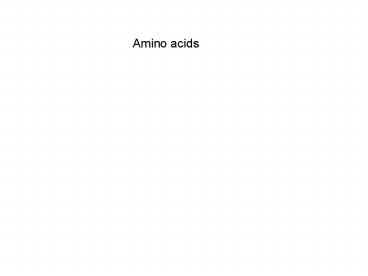Amino acids - PowerPoint PPT Presentation
1 / 20
Title:
Amino acids
Description:
Describe the R groups of amino acids in terms of polar, nonpolar, aromatic, ... Substances having this dual nature are amphoteric and are often called ampholytes. ... – PowerPoint PPT presentation
Number of Views:51
Avg rating:3.0/5.0
Title: Amino acids
1
Amino acids
2
Learning Objectives
Identify and recognize the structures of the 20
common amino acids and selenocysteine and name
each structure.
Describe the structural features of the amino
acids.
Describe the R groups of amino acids in terms of
polar, nonpolar, aromatic, negatively and
positively charged.
Describe the identification of the carbon atoms
in an amino acid.
Estimate the state of ionization of the R group
at a specific pH, given the pKa.
Define the term zwitterion.
3
Learning Objectives
Define a chiral carbon, enantiomers, and
stereoisomers.
Define and describe isoelectric point and the
buffering region in a titration curve of an amino
acid.
Identify and name the essential amino acids in
humans.
4
General structure of an amino acid
This structure is common to all but one of the
a-amino acids. Proline, a cyclic amino acid, is
the exception. The R group or side chain (red)
attached to the a carbon (blue) is different in
each amino acid.
5
Structural features of the amino acids
The standard amino acids found in proteins are
a-amino acids.
They have a carboxyl group and an amino group
bonded to the same carbon (the a carbon).
They differ from each other in their side chains
or R groups
Except for glycine, the a-carbon is a chiral
center. The amino acids in proteins are L
stereoisomers.
6
chiral carbon atom a carbon bonded to four
different groups.
enantiomers or optical isomers the two
mirror-image forms of a chiral molecule
Enantiomers are one kind of stereoisomers.
stereoisomers isomers that have the same
molecular and structural formula, but different
spatial (or three-dimensional) arrangements of
their atoms.
7
All molecules with a chiral center are optically
active.
The L, D system is based upon the absolute
configuration of glyceraldehyde. (proposed by
Emil Fisher in 1891)
8
Cahn-Ingold-Prelog or R,S system
In this system, all the amino acids from proteins
are (S)-amino acids (a-carbon), with the
exception of L-cysteine which is (R)-cysteine.
9
Identification of carbons in amino acids
The additional carbons in an R group are commonly
designated b, g, d, e, and so forth, proceeding
out from the a carbon.
10
The structural formulas show the state of
ionization that would predominate at pH 7.0.
11
(No Transcript)
12
(No Transcript)
13
(No Transcript)
14
(No Transcript)
15
Nutrition
Amino acids essential in the diet
lysine isoleucine leucine threonine valine
tryptophan phenylalanine methionine
histidine arginine
(required for growth, but not in the adult)
16
Absorbance of ultraviolet light by aromatic amino
acids
Comparison of the UV absorbance of tryptophan and
tyrosine (both at 10-3 M) at pH 6.0. Maximal
absorbance for both amino acids is around 280 nm.
17
Reversible formation of a disulfide bond by the
oxidation of two molecules of cysteine.
Disulfide bonds between cys residues in proteins
stabilize the structures of many proteins.
18
Non-standard amino acids
Selenium functions as a necessary component of
enzymes involved in antioxidant protection
(glutathione peroxidase and thioredoxin
reductase) and thyroid hormone metabolism.
Selenium is incorporated as selenocysteine into a
wide range of selenoproteins. At least 30 have
been identified.
Selenocysteine
This amino acid is specifically coded for in the
mRNA of selenoproteins. A specific tRNA is
charged with selenocysteine and is incorporated
into the appropriate proteins during translation.
19
Amino acids can act as acids and bases
When an amino acid is dissolved in water, it
exists in solution as the dipolar ion, or
zwitterion. A zwitterion can act as either an
acid or a base.
Substances having this dual nature are amphoteric
and are often called ampholytes.
20
Amino acids have characteristic titration curves
pI isoelectricpoint
isoelectric point the pH at which a sample of an
amino acid has equal numbers of and charges.































